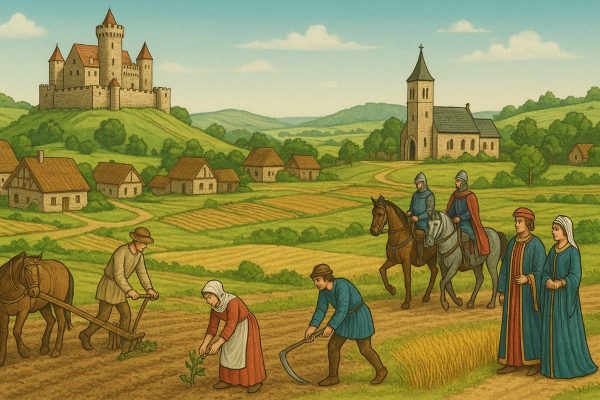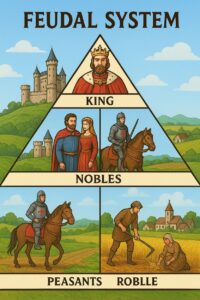1st PUC History Question and Answer – Medieval Period
Looking for 1st PUC History textbook answers? You can download Chapter 6: Medieval Period Questions and Answers PDF, Notes, and Summary here. 1st PUC History solutions follow the Karnataka State Board Syllabus, making it easier for students to revise and score higher in exams.
Karnataka 1st PUC History Textbook Answers—Reflections Chapter 6
Medieval PeriodQuestions and Answers, Notes, and Summary
1st PUC History Chapter 6
Medieval Period
Towards Change Chruch, Society & State – Feudalism
Scroll Down to Downlaod Medieval Period PDF
I. Answer in a word or one sentence.
Question 1.
Which was the “Divine language” of Medieval Christianity?
Answer:
The “Divine language” of Medieval Christianity was Latin.
Question 2.
To which place was the papal court shifted from Rome?
Answer:
The papal court was shifted from Rome to Avignon.
Question 3.
Who wrote the book ‘Divine Comedy’?
Answer:
The book ‘Divine Comedy’ was written by Dante Alighieri.
Question 4.
What is fief?
Answer:
A fief is a piece of land granted by a lord to a vassal in the feudal system.
Question 5.
Who was the first pope to make Avignon as his Centre?
Answer:
The first pope to make Avignon as his Centre was Pope Clement V.
Question 6.
Why Early Middle Ages is called ‘Dark Age’?
Answer:
The Early Middle Ages is called the ‘Dark Age’ because of the confused and chaotic state of affairs in Europe.
Question 7.
Which pope deposed King Henry IV?
Answer:
Pope Gregory VII deposed King Henry IV.
Question 8.
Who were Vassals?
Answer:
Vassals were people who received land (fief) from a lord in return for loyalty and services.
Question 9.
When did the papal schism end?
Answer:
The papal schism ended in 1414 CE.
Question 10.
Who wrote the book ‘Canterbury tales’?
Answer:
The book ‘Canterbury Tales’ was written by Geoffrey Chaucer.
II. Answer in 2 words or 2 sentences.
Question 1.
Mention any two causes for the decline of pope’s authority in the 14th century?
Answer:
The decline of the pope’s authority was caused by immoral successors and the rise of national monarchies.
Question 2.
Name any two trade centres of Medieval Europe.
Answer:
The two trade centres of Medieval Europe were Venice and Genoa.
Question 3.
Name any two universities that came into existence in Medieval Europe.
Answer:
The two universities that came into existence were Oxford and Cambridge.
Question 4.
Name any two intellectuals of Medieval Europe.
Answer:
The two intellectuals of Medieval Europe were Roger Bacon and St. Thomas Aquinas.
Question 5.
Name any two literary styles of Medieval Europe.
Answer:
The two literary styles of Medieval Europe were Romances and Fabliaux.
Question 6.
Which are the styles of architecture found in the Medieval Europe?
Answer:
The styles of architecture found in Medieval Europe were Romanesque and Gothic.
Question 7.
From which word is ‘feudalism’ derived? What is its meaning?
Answer:
The word ‘feudalism’ is derived from the German word ‘Feud’ which means a piece of land.
Question 8.
Mention the pyrimidical structural hierarchy of feudalism.
Answer:
The pyramidical structure of feudalism was King → Nobles → Knights → Vassals → Peasants/Serfs.
Question 9.
Write two features of Romanic style.
Answer:
Two features of Romanic style were rounded arches and massive stone walls.
Question 10.
Write two features of Gothic style.
Answer:
Two features of Gothic style were pointed arches and ribbed vaulting.
Question 11.
Name the two factors that speeded up the agricultural production in Medieval Europe.
Answer:
Two factors that speeded up agricultural production were the use of the heavy plough and the practice of crop rotation.
III. Answer in 15 – 20 sentences.
Question 1.
Write about Manorial system.
Answer:
The Manorial system was the basic economic and social unit of Medieval Europe. It was based on the ownership of land by the lord and the services provided by peasants or serfs. The lord of the manor lived in a castle or large house, while peasants worked in the surrounding lands. A manor was usually self-sufficient, producing all necessary goods like food, clothing, and tools. The peasants were bound to the land and could not leave without the lord’s permission. In return for their labor, they were given small plots of land for their own use. The manor also had a church, as religion was an important part of life.
The lord provided protection to the peasants during invasions or wars. The system created a bond of dependency between the lord and peasants. There were also free peasants, but most were serfs tied to the land. The manor was divided into demesne (lord’s land) and tenant land. Taxes and rents were paid in the form of crops, animals, or services. The system ensured stability and food supply but limited social mobility. Manorialism lasted for centuries and shaped the rural economy of Europe. It declined with the growth of trade, towns, and new agricultural methods. Overall, it was the backbone of feudal society during the Middle Ages.
Question 2.
Mark the socio-economic changes in Medieval Europe.
Answer:
- Medieval Europe witnessed several important socio-economic changes.
- Agriculture, which was earlier in a primitive stage, improved with new tools like the heavy plough, crop rotation, windmills, and watermills.
- This caused a rise in food production and population growth. With surplus production, small villages grew into towns and cities.
- The Manorial system organized agricultural life, where serfs worked under Lords but later paid rents in money.
- The use of currency replaced barter, giving rise to a money economy. This change boosted trade and commerce.
- Cities like Venice, Pisa, and Genoa became trade hubs, while Paris and London expanded.
- A new business class of merchants and craftsmen emerged.
- They organized themselves into guilds to regulate trade and protect their interests.
- The Nobility developed cultural traditions such as knighthood and chivalry, which shaped social life.
- Attitudes towards women also improved with the spread of chivalry.
- Education grew, with universities like Oxford and Paris promoting learning beyond church control.
- The literacy rate increased and vernacular languages developed in literature.
- The clergy was divided into higher clergy, who lived luxuriously, and lower clergy, who lived simply.
- This caused resentment towards the higher church leaders.
- Urbanization and trade brought a more sophisticated lifestyle to people.
Question 3.
Describe the conflict between the pope and the king in Medieval Europe.
Answer:
The conflict between the pope and the king was one of the central issues of Medieval Europe. The struggle was mainly about supremacy between spiritual authority and temporal power. The Church claimed authority over kings, stating that popes had divine right to rule over Christian society. Kings, however, wanted to control their own territories without interference from the Church. One major conflict arose between Pope Gregory VII and King Henry IV of Germany over the issue of lay investiture. Gregory declared that only the pope could appoint bishops, while Henry insisted on his right to do so. When Henry defied him, Gregory excommunicated the king.
Henry was forced to submit to the pope at Canossa in 1077, which showed the power of the papacy. Similar conflicts occurred in France and England where kings tried to tax the clergy. The dispute weakened both sides in the long run. The Avignon Papacy and the Great Schism further reduced the Church’s authority. Monarchs eventually grew stronger, while the papacy lost much of its influence. This conflict changed the balance of power in Europe. It also led to the rise of nation-states and the decline of papal supremacy.
Question 4.
Discuss the Merits and Demerits of feudalism.
Answer:
Feudalism was a political, social, and economic system based on land ownership.
It had both merits and demerits.
Merits:
- Feudalism provided decentralized administration during a time of instability.
- It preserved monarchy, as vassals swore loyalty to the king.
- It ensured collective defense against invasions.
The constant wars led to improved military techniques and training. - The idea of chivalry developed, promoting respect for women and care for the poor.
- It maintained law and order within estates.
It created a sense of duty and responsibility at every level of society.
Demerits:
- Feudalism often caused wars between vassals and lords, leading to instability.
- The loyalty of people was only to their lords, not to the nation or king.
- The nobles were self-interested, and serfs suffered under their tyranny.
- It widened the gap between the rich and poor.
- The Church also acted as a feudal lord, leading to more conflicts.
- Thus, feudalism was useful in providing order but also caused inequality and hindered national unity.
Question 5.
What were the causes for the decline of feudalism?
Answer:
- Feudalism began to decline in Europe by the end of the Middle Ages.
- One major reason was the rise of strong monarchies.
- Kings built powerful centralized states and suppressed feudal lords.
- Common people and serfs shifted their loyalty from lords to kings, who gave them better protection.
- The growth of commerce and industry created new jobs, and people left feudal lands.
- This gave rise to the middle class, reducing the need for feudal lords.
- A money economy replaced payments in services, weakening feudal obligations.
- The kings built strong standing armies using gunpowder weapons.
- Now common people depended on the king’s army instead of the lord’s knights.
- The spread of the Black Death (plague) reduced the population drastically.
- This created a scarcity of workers, raising their wages and weakening lordly control.
- Internal conflicts between feudal lords also reduced their power.
- The Church imposed restrictions on feudal wars, further weakening them.
- Urbanization and education reduced dependence on rural lords.
- Overall, feudalism declined due to political, economic, social, and military changes.
- This decline paved the way for the rise of nation-states in Europe.
Additional Questions & Answers
1 Mark Questions (Answer in one word or one sentence)
Question 1.
What is the meaning of Feudalism?
Answer:
Feudalism was a system where land was granted in exchange for loyalty and service.
Question 2.
Who were Serfs?
Answer:
Serfs were peasants bound to the land who worked for their lords.
Question 3.
What was the role of the Church in Medieval Europe?
Answer:
The Church controlled spiritual life, politics, and education.
Question 4.
Name two agricultural innovations of the Middle Ages.
Answer:
Heavy plough and the three-field system.
Question 5.
What was the Investiture Controversy?
Answer:
A conflict between Pope Gregory VII and King Henry IV over appointing bishops.
2 Mark Questions (Answer in two words or two sentences)
Question 1.
Mention two causes for the decline of feudalism.
Answer:
The Black Death reduced population, and trade growth led to a money economy.
Question 2.
What was the significance of the Crusades?
Answer:
The Crusades increased trade, spread knowledge, and weakened feudalism.
Question 3.
Name two features of Manorialism.
Answer:
The manor was self-sufficient, and peasants worked on the lord’s demesne.
Question 4.
Who were the vassals?
Answer:
Vassals were nobles who received land (fiefs) in return for loyalty and military service.
Question 5.
Write any two merits of Feudalism.
Answer:
It provided protection and ensured social order.
5 Mark Questions (Answer in 15–20 sentences / a short paragraph)
Question 1.
Write about the Investiture Controversy.
Answer:
The Investiture Controversy was a major conflict between Pope Gregory VII and King Henry IV in the 11th century. The issue was about who held the authority to appoint bishops and abbots—the Pope or the King. Pope Gregory VII argued that only the Pope had the right to invest bishops with spiritual authority, while Henry IV insisted that as king he had the right to appoint church officials within his territory. This led to open conflict, where Gregory excommunicated Henry IV, and Henry in turn declared Gregory deposed. Eventually, Henry IV had to seek forgiveness at Canossa in 1077, which was a symbolic victory for the papacy.
The controversy highlighted the struggle between church and state and resulted in the Concordat of Worms (1122), which compromised that the Pope would appoint bishops spiritually, while kings retained influence over their temporal authority. This conflict marked a turning point in medieval politics and weakened feudal lords while strengthening centralized powers.


